ETHICAL CONCERNS OF NURSING PRACTICE
VerifiedAdded on 2022/08/14
|9
|3024
|16
AI Summary
Contribute Materials
Your contribution can guide someone’s learning journey. Share your
documents today.
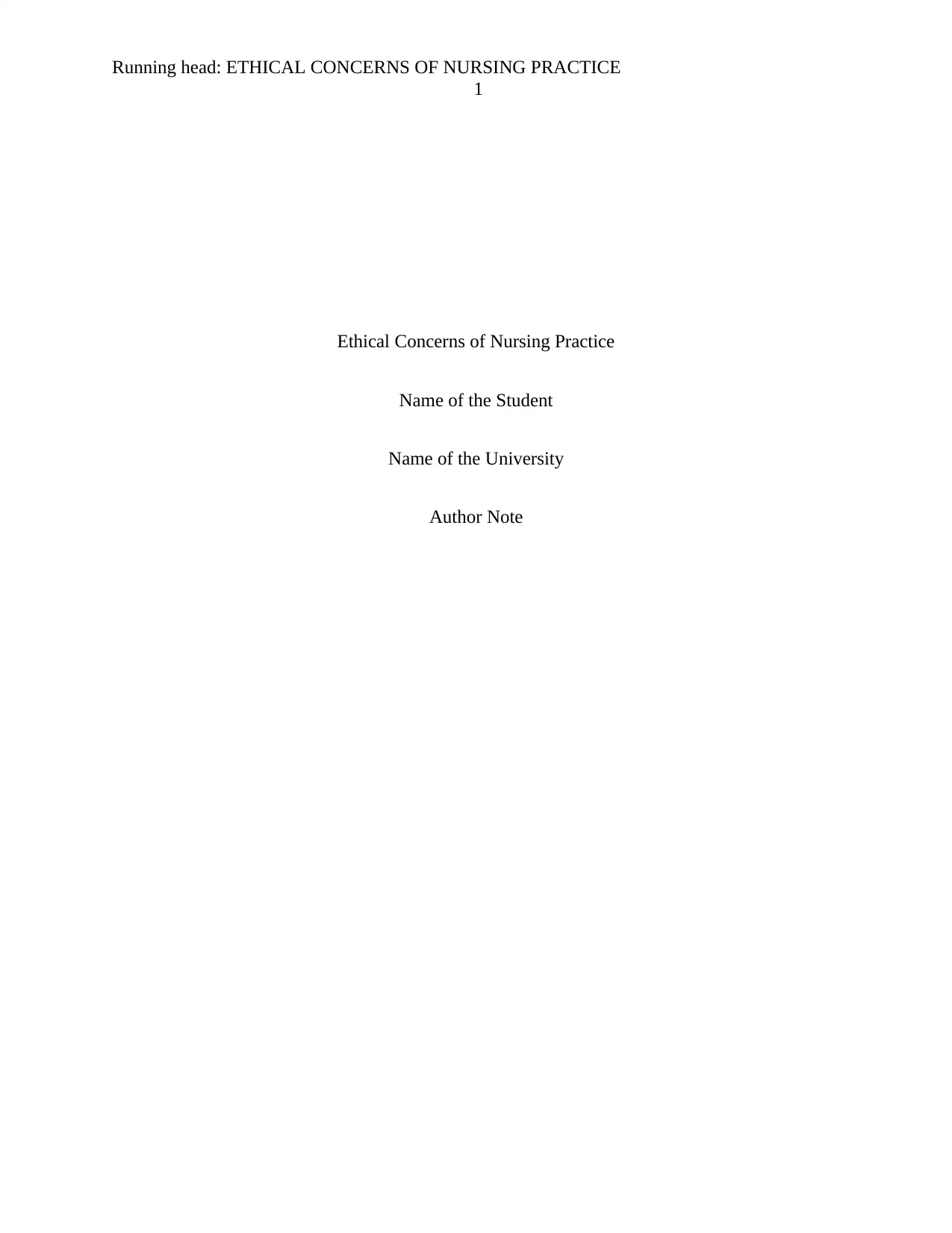
Running head: ETHICAL CONCERNS OF NURSING PRACTICE
1
Ethical Concerns of Nursing Practice
Name of the Student
Name of the University
Author Note
1
Ethical Concerns of Nursing Practice
Name of the Student
Name of the University
Author Note
Secure Best Marks with AI Grader
Need help grading? Try our AI Grader for instant feedback on your assignments.
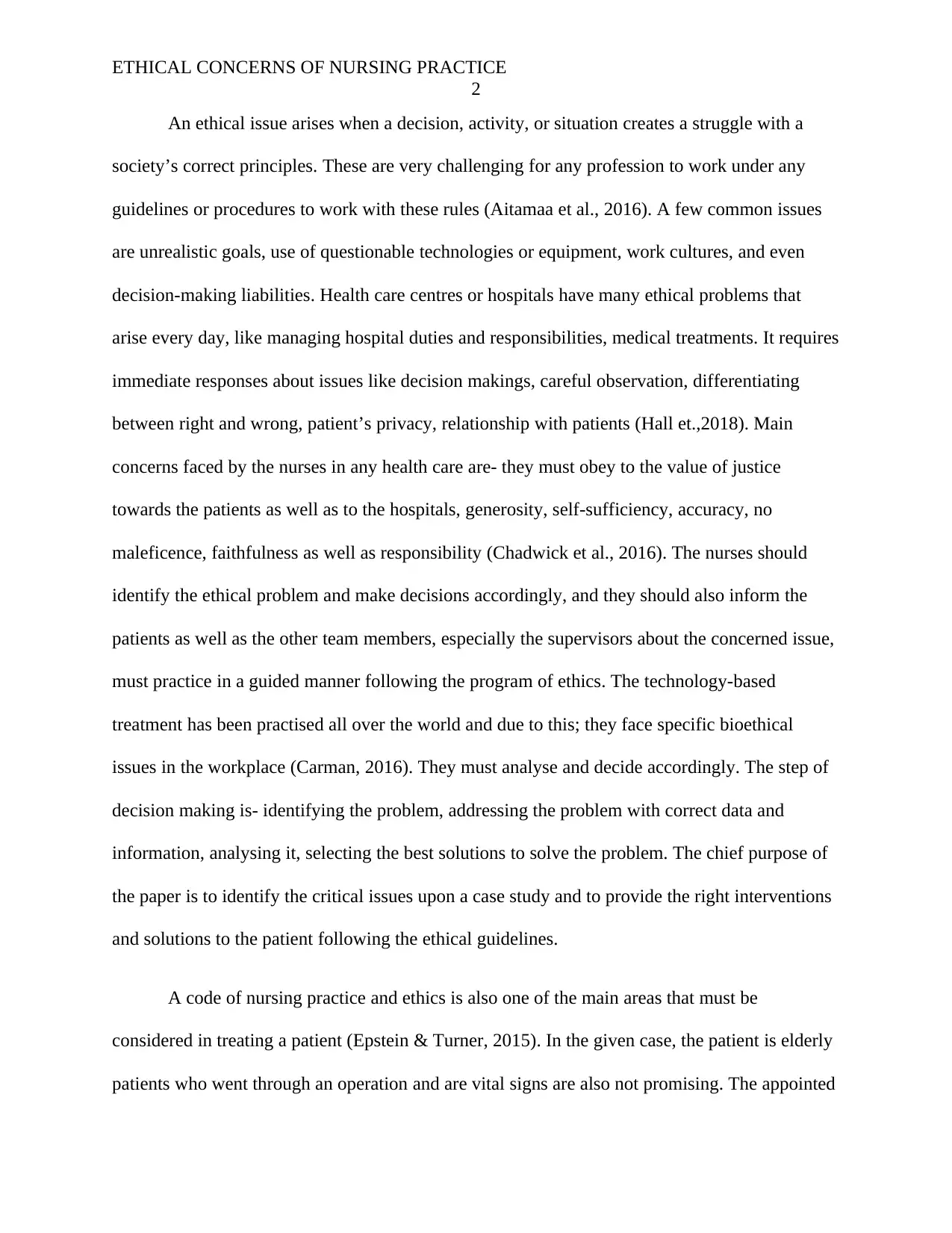
ETHICAL CONCERNS OF NURSING PRACTICE
2
An ethical issue arises when a decision, activity, or situation creates a struggle with a
society’s correct principles. These are very challenging for any profession to work under any
guidelines or procedures to work with these rules (Aitamaa et al., 2016). A few common issues
are unrealistic goals, use of questionable technologies or equipment, work cultures, and even
decision-making liabilities. Health care centres or hospitals have many ethical problems that
arise every day, like managing hospital duties and responsibilities, medical treatments. It requires
immediate responses about issues like decision makings, careful observation, differentiating
between right and wrong, patient’s privacy, relationship with patients (Hall et.,2018). Main
concerns faced by the nurses in any health care are- they must obey to the value of justice
towards the patients as well as to the hospitals, generosity, self-sufficiency, accuracy, no
maleficence, faithfulness as well as responsibility (Chadwick et al., 2016). The nurses should
identify the ethical problem and make decisions accordingly, and they should also inform the
patients as well as the other team members, especially the supervisors about the concerned issue,
must practice in a guided manner following the program of ethics. The technology-based
treatment has been practised all over the world and due to this; they face specific bioethical
issues in the workplace (Carman, 2016). They must analyse and decide accordingly. The step of
decision making is- identifying the problem, addressing the problem with correct data and
information, analysing it, selecting the best solutions to solve the problem. The chief purpose of
the paper is to identify the critical issues upon a case study and to provide the right interventions
and solutions to the patient following the ethical guidelines.
A code of nursing practice and ethics is also one of the main areas that must be
considered in treating a patient (Epstein & Turner, 2015). In the given case, the patient is elderly
patients who went through an operation and are vital signs are also not promising. The appointed
2
An ethical issue arises when a decision, activity, or situation creates a struggle with a
society’s correct principles. These are very challenging for any profession to work under any
guidelines or procedures to work with these rules (Aitamaa et al., 2016). A few common issues
are unrealistic goals, use of questionable technologies or equipment, work cultures, and even
decision-making liabilities. Health care centres or hospitals have many ethical problems that
arise every day, like managing hospital duties and responsibilities, medical treatments. It requires
immediate responses about issues like decision makings, careful observation, differentiating
between right and wrong, patient’s privacy, relationship with patients (Hall et.,2018). Main
concerns faced by the nurses in any health care are- they must obey to the value of justice
towards the patients as well as to the hospitals, generosity, self-sufficiency, accuracy, no
maleficence, faithfulness as well as responsibility (Chadwick et al., 2016). The nurses should
identify the ethical problem and make decisions accordingly, and they should also inform the
patients as well as the other team members, especially the supervisors about the concerned issue,
must practice in a guided manner following the program of ethics. The technology-based
treatment has been practised all over the world and due to this; they face specific bioethical
issues in the workplace (Carman, 2016). They must analyse and decide accordingly. The step of
decision making is- identifying the problem, addressing the problem with correct data and
information, analysing it, selecting the best solutions to solve the problem. The chief purpose of
the paper is to identify the critical issues upon a case study and to provide the right interventions
and solutions to the patient following the ethical guidelines.
A code of nursing practice and ethics is also one of the main areas that must be
considered in treating a patient (Epstein & Turner, 2015). In the given case, the patient is elderly
patients who went through an operation and are vital signs are also not promising. The appointed
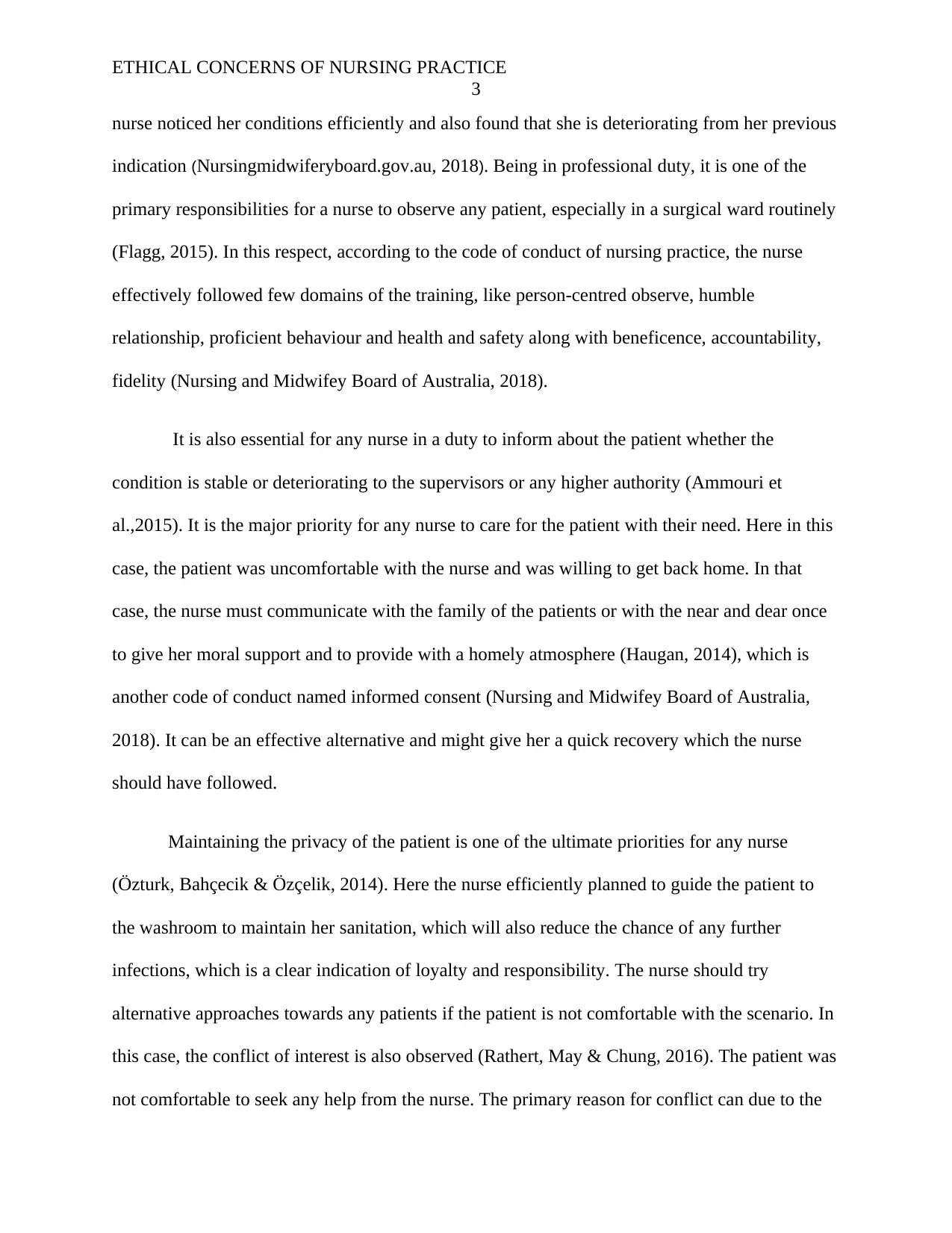
ETHICAL CONCERNS OF NURSING PRACTICE
3
nurse noticed her conditions efficiently and also found that she is deteriorating from her previous
indication (Nursingmidwiferyboard.gov.au, 2018). Being in professional duty, it is one of the
primary responsibilities for a nurse to observe any patient, especially in a surgical ward routinely
(Flagg, 2015). In this respect, according to the code of conduct of nursing practice, the nurse
effectively followed few domains of the training, like person-centred observe, humble
relationship, proficient behaviour and health and safety along with beneficence, accountability,
fidelity (Nursing and Midwifey Board of Australia, 2018).
It is also essential for any nurse in a duty to inform about the patient whether the
condition is stable or deteriorating to the supervisors or any higher authority (Ammouri et
al.,2015). It is the major priority for any nurse to care for the patient with their need. Here in this
case, the patient was uncomfortable with the nurse and was willing to get back home. In that
case, the nurse must communicate with the family of the patients or with the near and dear once
to give her moral support and to provide with a homely atmosphere (Haugan, 2014), which is
another code of conduct named informed consent (Nursing and Midwifey Board of Australia,
2018). It can be an effective alternative and might give her a quick recovery which the nurse
should have followed.
Maintaining the privacy of the patient is one of the ultimate priorities for any nurse
(Özturk, Bahçecik & Özçelik, 2014). Here the nurse efficiently planned to guide the patient to
the washroom to maintain her sanitation, which will also reduce the chance of any further
infections, which is a clear indication of loyalty and responsibility. The nurse should try
alternative approaches towards any patients if the patient is not comfortable with the scenario. In
this case, the conflict of interest is also observed (Rathert, May & Chung, 2016). The patient was
not comfortable to seek any help from the nurse. The primary reason for conflict can due to the
3
nurse noticed her conditions efficiently and also found that she is deteriorating from her previous
indication (Nursingmidwiferyboard.gov.au, 2018). Being in professional duty, it is one of the
primary responsibilities for a nurse to observe any patient, especially in a surgical ward routinely
(Flagg, 2015). In this respect, according to the code of conduct of nursing practice, the nurse
effectively followed few domains of the training, like person-centred observe, humble
relationship, proficient behaviour and health and safety along with beneficence, accountability,
fidelity (Nursing and Midwifey Board of Australia, 2018).
It is also essential for any nurse in a duty to inform about the patient whether the
condition is stable or deteriorating to the supervisors or any higher authority (Ammouri et
al.,2015). It is the major priority for any nurse to care for the patient with their need. Here in this
case, the patient was uncomfortable with the nurse and was willing to get back home. In that
case, the nurse must communicate with the family of the patients or with the near and dear once
to give her moral support and to provide with a homely atmosphere (Haugan, 2014), which is
another code of conduct named informed consent (Nursing and Midwifey Board of Australia,
2018). It can be an effective alternative and might give her a quick recovery which the nurse
should have followed.
Maintaining the privacy of the patient is one of the ultimate priorities for any nurse
(Özturk, Bahçecik & Özçelik, 2014). Here the nurse efficiently planned to guide the patient to
the washroom to maintain her sanitation, which will also reduce the chance of any further
infections, which is a clear indication of loyalty and responsibility. The nurse should try
alternative approaches towards any patients if the patient is not comfortable with the scenario. In
this case, the conflict of interest is also observed (Rathert, May & Chung, 2016). The patient was
not comfortable to seek any help from the nurse. The primary reason for conflict can due to the
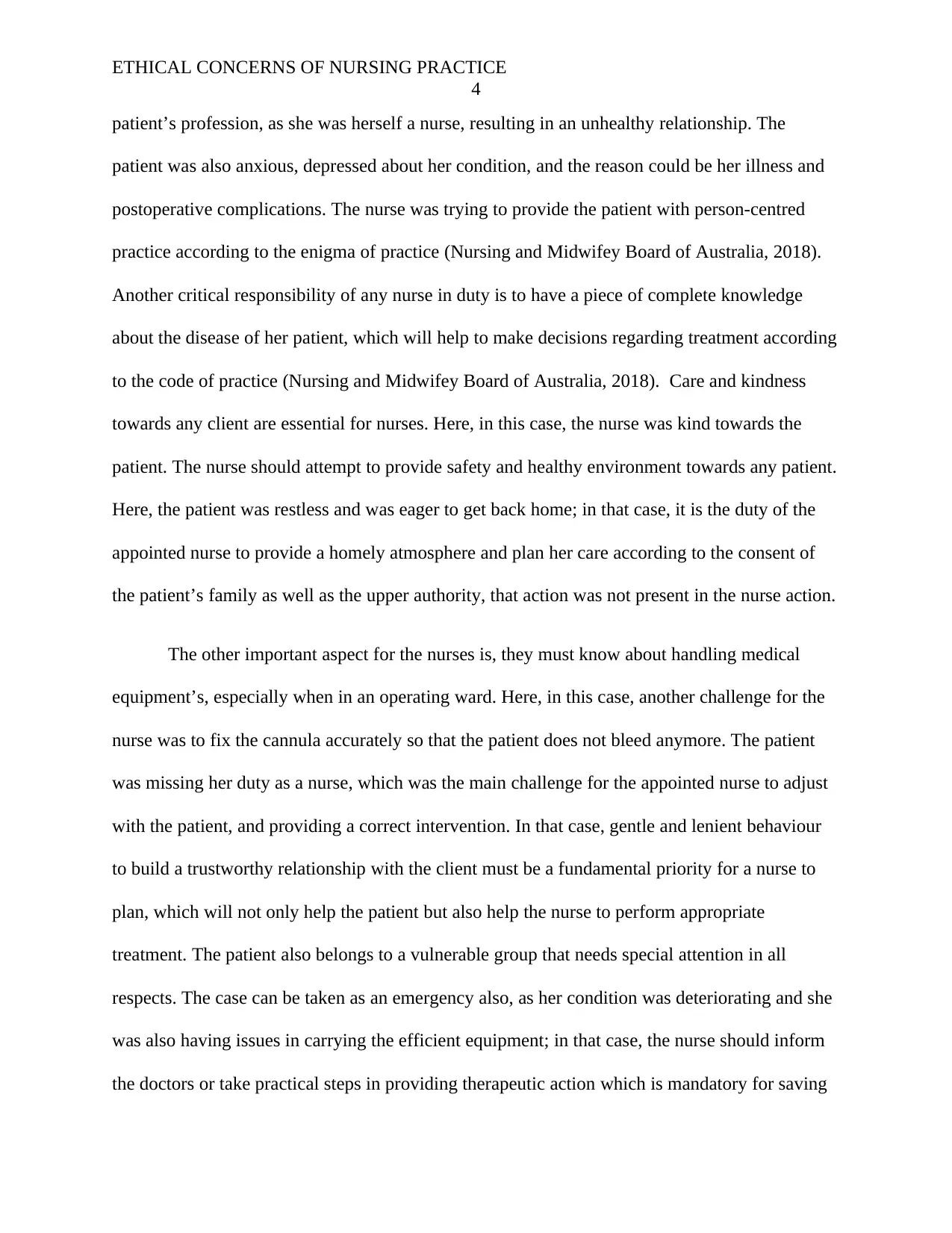
ETHICAL CONCERNS OF NURSING PRACTICE
4
patient’s profession, as she was herself a nurse, resulting in an unhealthy relationship. The
patient was also anxious, depressed about her condition, and the reason could be her illness and
postoperative complications. The nurse was trying to provide the patient with person-centred
practice according to the enigma of practice (Nursing and Midwifey Board of Australia, 2018).
Another critical responsibility of any nurse in duty is to have a piece of complete knowledge
about the disease of her patient, which will help to make decisions regarding treatment according
to the code of practice (Nursing and Midwifey Board of Australia, 2018). Care and kindness
towards any client are essential for nurses. Here, in this case, the nurse was kind towards the
patient. The nurse should attempt to provide safety and healthy environment towards any patient.
Here, the patient was restless and was eager to get back home; in that case, it is the duty of the
appointed nurse to provide a homely atmosphere and plan her care according to the consent of
the patient’s family as well as the upper authority, that action was not present in the nurse action.
The other important aspect for the nurses is, they must know about handling medical
equipment’s, especially when in an operating ward. Here, in this case, another challenge for the
nurse was to fix the cannula accurately so that the patient does not bleed anymore. The patient
was missing her duty as a nurse, which was the main challenge for the appointed nurse to adjust
with the patient, and providing a correct intervention. In that case, gentle and lenient behaviour
to build a trustworthy relationship with the client must be a fundamental priority for a nurse to
plan, which will not only help the patient but also help the nurse to perform appropriate
treatment. The patient also belongs to a vulnerable group that needs special attention in all
respects. The case can be taken as an emergency also, as her condition was deteriorating and she
was also having issues in carrying the efficient equipment; in that case, the nurse should inform
the doctors or take practical steps in providing therapeutic action which is mandatory for saving
4
patient’s profession, as she was herself a nurse, resulting in an unhealthy relationship. The
patient was also anxious, depressed about her condition, and the reason could be her illness and
postoperative complications. The nurse was trying to provide the patient with person-centred
practice according to the enigma of practice (Nursing and Midwifey Board of Australia, 2018).
Another critical responsibility of any nurse in duty is to have a piece of complete knowledge
about the disease of her patient, which will help to make decisions regarding treatment according
to the code of practice (Nursing and Midwifey Board of Australia, 2018). Care and kindness
towards any client are essential for nurses. Here, in this case, the nurse was kind towards the
patient. The nurse should attempt to provide safety and healthy environment towards any patient.
Here, the patient was restless and was eager to get back home; in that case, it is the duty of the
appointed nurse to provide a homely atmosphere and plan her care according to the consent of
the patient’s family as well as the upper authority, that action was not present in the nurse action.
The other important aspect for the nurses is, they must know about handling medical
equipment’s, especially when in an operating ward. Here, in this case, another challenge for the
nurse was to fix the cannula accurately so that the patient does not bleed anymore. The patient
was missing her duty as a nurse, which was the main challenge for the appointed nurse to adjust
with the patient, and providing a correct intervention. In that case, gentle and lenient behaviour
to build a trustworthy relationship with the client must be a fundamental priority for a nurse to
plan, which will not only help the patient but also help the nurse to perform appropriate
treatment. The patient also belongs to a vulnerable group that needs special attention in all
respects. The case can be taken as an emergency also, as her condition was deteriorating and she
was also having issues in carrying the efficient equipment; in that case, the nurse should inform
the doctors or take practical steps in providing therapeutic action which is mandatory for saving
Secure Best Marks with AI Grader
Need help grading? Try our AI Grader for instant feedback on your assignments.
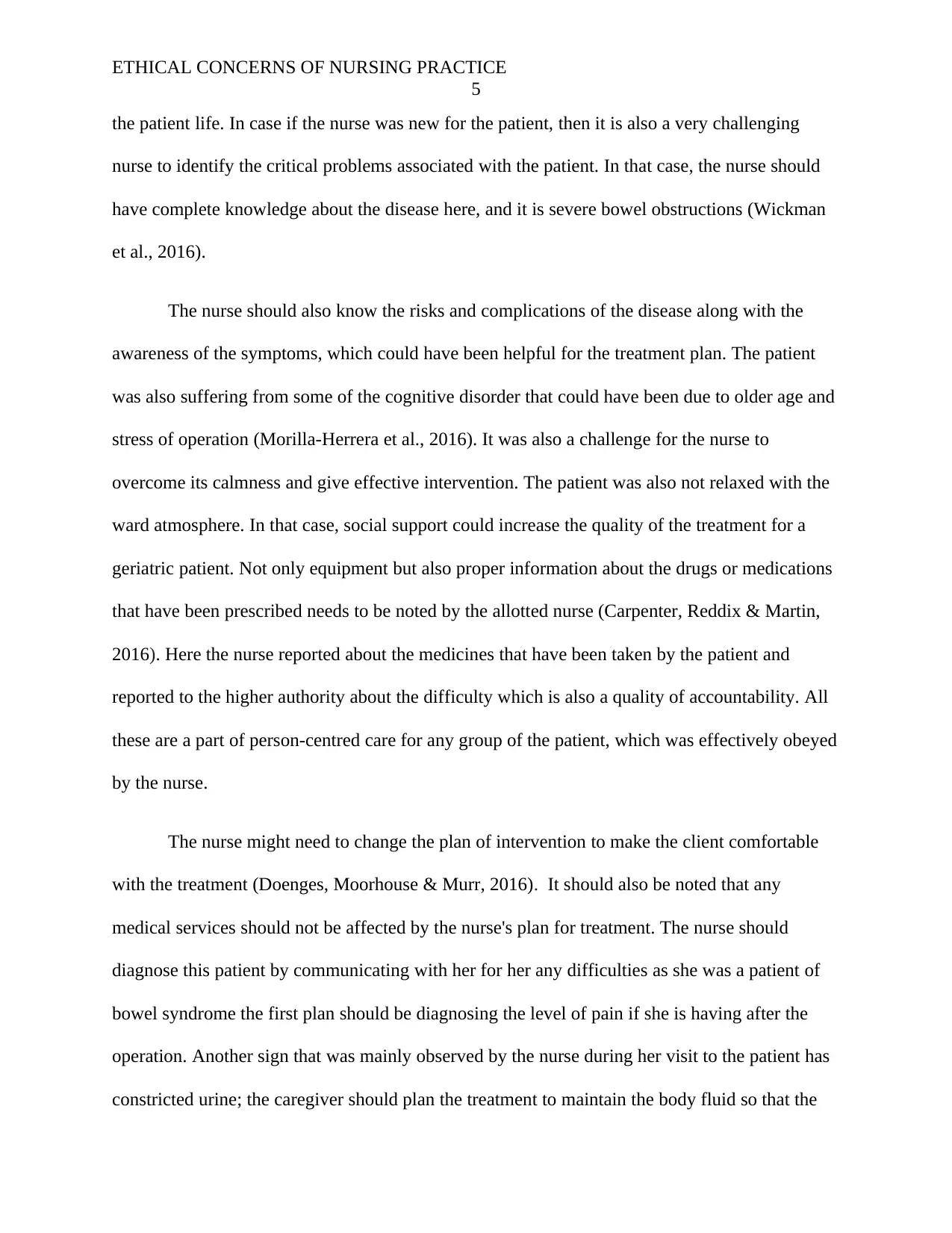
ETHICAL CONCERNS OF NURSING PRACTICE
5
the patient life. In case if the nurse was new for the patient, then it is also a very challenging
nurse to identify the critical problems associated with the patient. In that case, the nurse should
have complete knowledge about the disease here, and it is severe bowel obstructions (Wickman
et al., 2016).
The nurse should also know the risks and complications of the disease along with the
awareness of the symptoms, which could have been helpful for the treatment plan. The patient
was also suffering from some of the cognitive disorder that could have been due to older age and
stress of operation (Morilla-Herrera et al., 2016). It was also a challenge for the nurse to
overcome its calmness and give effective intervention. The patient was also not relaxed with the
ward atmosphere. In that case, social support could increase the quality of the treatment for a
geriatric patient. Not only equipment but also proper information about the drugs or medications
that have been prescribed needs to be noted by the allotted nurse (Carpenter, Reddix & Martin,
2016). Here the nurse reported about the medicines that have been taken by the patient and
reported to the higher authority about the difficulty which is also a quality of accountability. All
these are a part of person-centred care for any group of the patient, which was effectively obeyed
by the nurse.
The nurse might need to change the plan of intervention to make the client comfortable
with the treatment (Doenges, Moorhouse & Murr, 2016). It should also be noted that any
medical services should not be affected by the nurse's plan for treatment. The nurse should
diagnose this patient by communicating with her for her any difficulties as she was a patient of
bowel syndrome the first plan should be diagnosing the level of pain if she is having after the
operation. Another sign that was mainly observed by the nurse during her visit to the patient has
constricted urine; the caregiver should plan the treatment to maintain the body fluid so that the
5
the patient life. In case if the nurse was new for the patient, then it is also a very challenging
nurse to identify the critical problems associated with the patient. In that case, the nurse should
have complete knowledge about the disease here, and it is severe bowel obstructions (Wickman
et al., 2016).
The nurse should also know the risks and complications of the disease along with the
awareness of the symptoms, which could have been helpful for the treatment plan. The patient
was also suffering from some of the cognitive disorder that could have been due to older age and
stress of operation (Morilla-Herrera et al., 2016). It was also a challenge for the nurse to
overcome its calmness and give effective intervention. The patient was also not relaxed with the
ward atmosphere. In that case, social support could increase the quality of the treatment for a
geriatric patient. Not only equipment but also proper information about the drugs or medications
that have been prescribed needs to be noted by the allotted nurse (Carpenter, Reddix & Martin,
2016). Here the nurse reported about the medicines that have been taken by the patient and
reported to the higher authority about the difficulty which is also a quality of accountability. All
these are a part of person-centred care for any group of the patient, which was effectively obeyed
by the nurse.
The nurse might need to change the plan of intervention to make the client comfortable
with the treatment (Doenges, Moorhouse & Murr, 2016). It should also be noted that any
medical services should not be affected by the nurse's plan for treatment. The nurse should
diagnose this patient by communicating with her for her any difficulties as she was a patient of
bowel syndrome the first plan should be diagnosing the level of pain if she is having after the
operation. Another sign that was mainly observed by the nurse during her visit to the patient has
constricted urine; the caregiver should plan the treatment to maintain the body fluid so that the
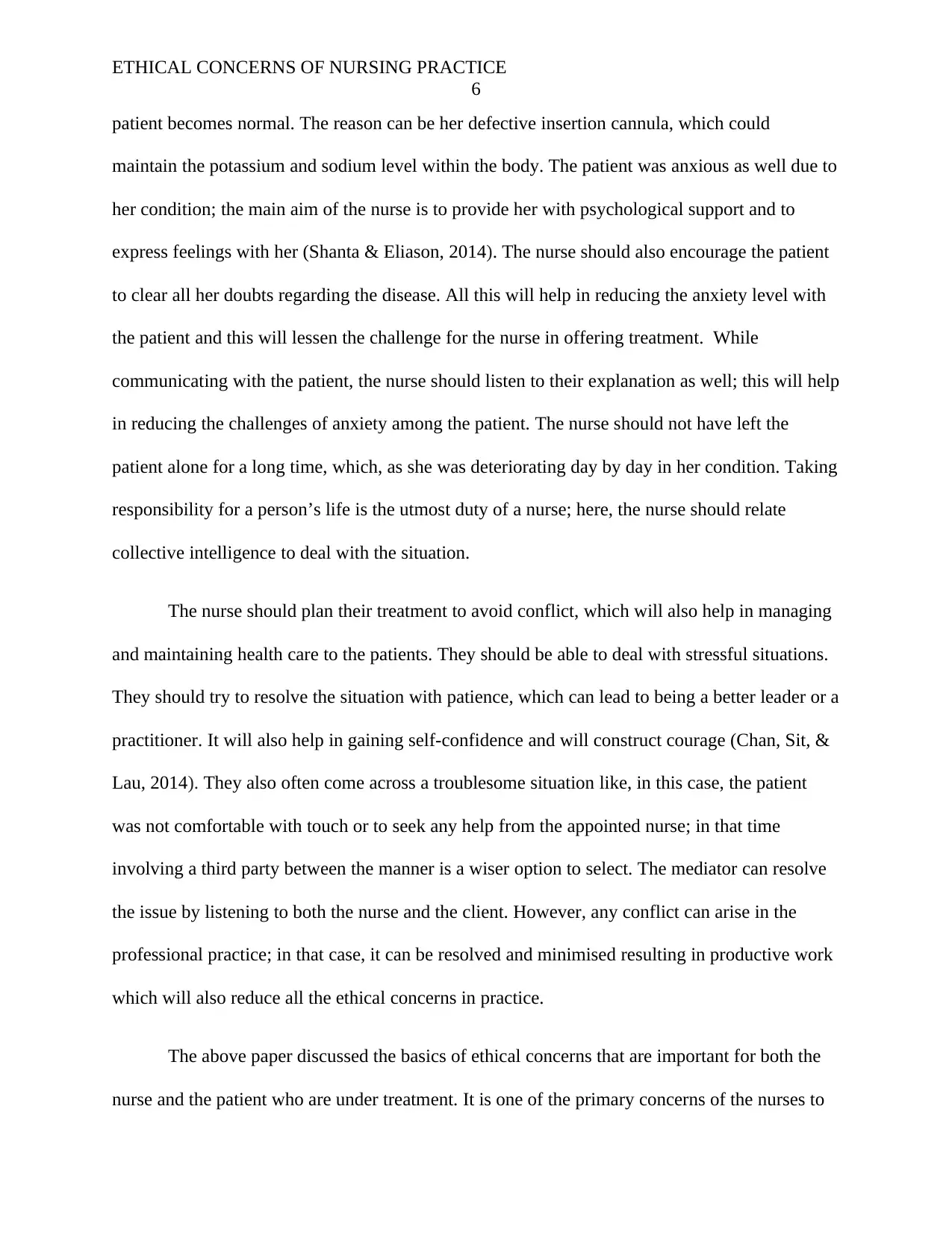
ETHICAL CONCERNS OF NURSING PRACTICE
6
patient becomes normal. The reason can be her defective insertion cannula, which could
maintain the potassium and sodium level within the body. The patient was anxious as well due to
her condition; the main aim of the nurse is to provide her with psychological support and to
express feelings with her (Shanta & Eliason, 2014). The nurse should also encourage the patient
to clear all her doubts regarding the disease. All this will help in reducing the anxiety level with
the patient and this will lessen the challenge for the nurse in offering treatment. While
communicating with the patient, the nurse should listen to their explanation as well; this will help
in reducing the challenges of anxiety among the patient. The nurse should not have left the
patient alone for a long time, which, as she was deteriorating day by day in her condition. Taking
responsibility for a person’s life is the utmost duty of a nurse; here, the nurse should relate
collective intelligence to deal with the situation.
The nurse should plan their treatment to avoid conflict, which will also help in managing
and maintaining health care to the patients. They should be able to deal with stressful situations.
They should try to resolve the situation with patience, which can lead to being a better leader or a
practitioner. It will also help in gaining self-confidence and will construct courage (Chan, Sit, &
Lau, 2014). They also often come across a troublesome situation like, in this case, the patient
was not comfortable with touch or to seek any help from the appointed nurse; in that time
involving a third party between the manner is a wiser option to select. The mediator can resolve
the issue by listening to both the nurse and the client. However, any conflict can arise in the
professional practice; in that case, it can be resolved and minimised resulting in productive work
which will also reduce all the ethical concerns in practice.
The above paper discussed the basics of ethical concerns that are important for both the
nurse and the patient who are under treatment. It is one of the primary concerns of the nurses to
6
patient becomes normal. The reason can be her defective insertion cannula, which could
maintain the potassium and sodium level within the body. The patient was anxious as well due to
her condition; the main aim of the nurse is to provide her with psychological support and to
express feelings with her (Shanta & Eliason, 2014). The nurse should also encourage the patient
to clear all her doubts regarding the disease. All this will help in reducing the anxiety level with
the patient and this will lessen the challenge for the nurse in offering treatment. While
communicating with the patient, the nurse should listen to their explanation as well; this will help
in reducing the challenges of anxiety among the patient. The nurse should not have left the
patient alone for a long time, which, as she was deteriorating day by day in her condition. Taking
responsibility for a person’s life is the utmost duty of a nurse; here, the nurse should relate
collective intelligence to deal with the situation.
The nurse should plan their treatment to avoid conflict, which will also help in managing
and maintaining health care to the patients. They should be able to deal with stressful situations.
They should try to resolve the situation with patience, which can lead to being a better leader or a
practitioner. It will also help in gaining self-confidence and will construct courage (Chan, Sit, &
Lau, 2014). They also often come across a troublesome situation like, in this case, the patient
was not comfortable with touch or to seek any help from the appointed nurse; in that time
involving a third party between the manner is a wiser option to select. The mediator can resolve
the issue by listening to both the nurse and the client. However, any conflict can arise in the
professional practice; in that case, it can be resolved and minimised resulting in productive work
which will also reduce all the ethical concerns in practice.
The above paper discussed the basics of ethical concerns that are important for both the
nurse and the patient who are under treatment. It is one of the primary concerns of the nurses to
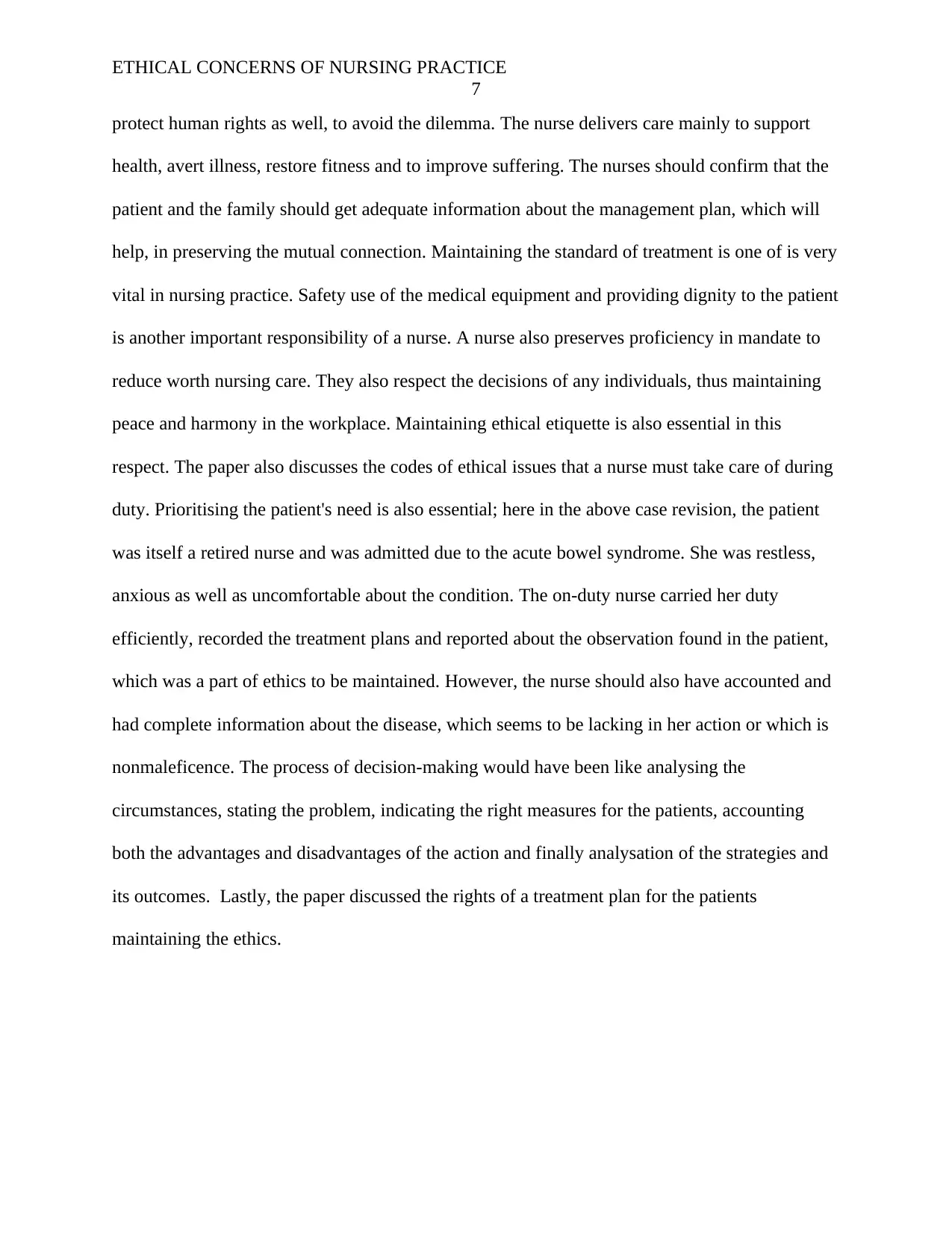
ETHICAL CONCERNS OF NURSING PRACTICE
7
protect human rights as well, to avoid the dilemma. The nurse delivers care mainly to support
health, avert illness, restore fitness and to improve suffering. The nurses should confirm that the
patient and the family should get adequate information about the management plan, which will
help, in preserving the mutual connection. Maintaining the standard of treatment is one of is very
vital in nursing practice. Safety use of the medical equipment and providing dignity to the patient
is another important responsibility of a nurse. A nurse also preserves proficiency in mandate to
reduce worth nursing care. They also respect the decisions of any individuals, thus maintaining
peace and harmony in the workplace. Maintaining ethical etiquette is also essential in this
respect. The paper also discusses the codes of ethical issues that a nurse must take care of during
duty. Prioritising the patient's need is also essential; here in the above case revision, the patient
was itself a retired nurse and was admitted due to the acute bowel syndrome. She was restless,
anxious as well as uncomfortable about the condition. The on-duty nurse carried her duty
efficiently, recorded the treatment plans and reported about the observation found in the patient,
which was a part of ethics to be maintained. However, the nurse should also have accounted and
had complete information about the disease, which seems to be lacking in her action or which is
nonmaleficence. The process of decision-making would have been like analysing the
circumstances, stating the problem, indicating the right measures for the patients, accounting
both the advantages and disadvantages of the action and finally analysation of the strategies and
its outcomes. Lastly, the paper discussed the rights of a treatment plan for the patients
maintaining the ethics.
7
protect human rights as well, to avoid the dilemma. The nurse delivers care mainly to support
health, avert illness, restore fitness and to improve suffering. The nurses should confirm that the
patient and the family should get adequate information about the management plan, which will
help, in preserving the mutual connection. Maintaining the standard of treatment is one of is very
vital in nursing practice. Safety use of the medical equipment and providing dignity to the patient
is another important responsibility of a nurse. A nurse also preserves proficiency in mandate to
reduce worth nursing care. They also respect the decisions of any individuals, thus maintaining
peace and harmony in the workplace. Maintaining ethical etiquette is also essential in this
respect. The paper also discusses the codes of ethical issues that a nurse must take care of during
duty. Prioritising the patient's need is also essential; here in the above case revision, the patient
was itself a retired nurse and was admitted due to the acute bowel syndrome. She was restless,
anxious as well as uncomfortable about the condition. The on-duty nurse carried her duty
efficiently, recorded the treatment plans and reported about the observation found in the patient,
which was a part of ethics to be maintained. However, the nurse should also have accounted and
had complete information about the disease, which seems to be lacking in her action or which is
nonmaleficence. The process of decision-making would have been like analysing the
circumstances, stating the problem, indicating the right measures for the patients, accounting
both the advantages and disadvantages of the action and finally analysation of the strategies and
its outcomes. Lastly, the paper discussed the rights of a treatment plan for the patients
maintaining the ethics.
Paraphrase This Document
Need a fresh take? Get an instant paraphrase of this document with our AI Paraphraser
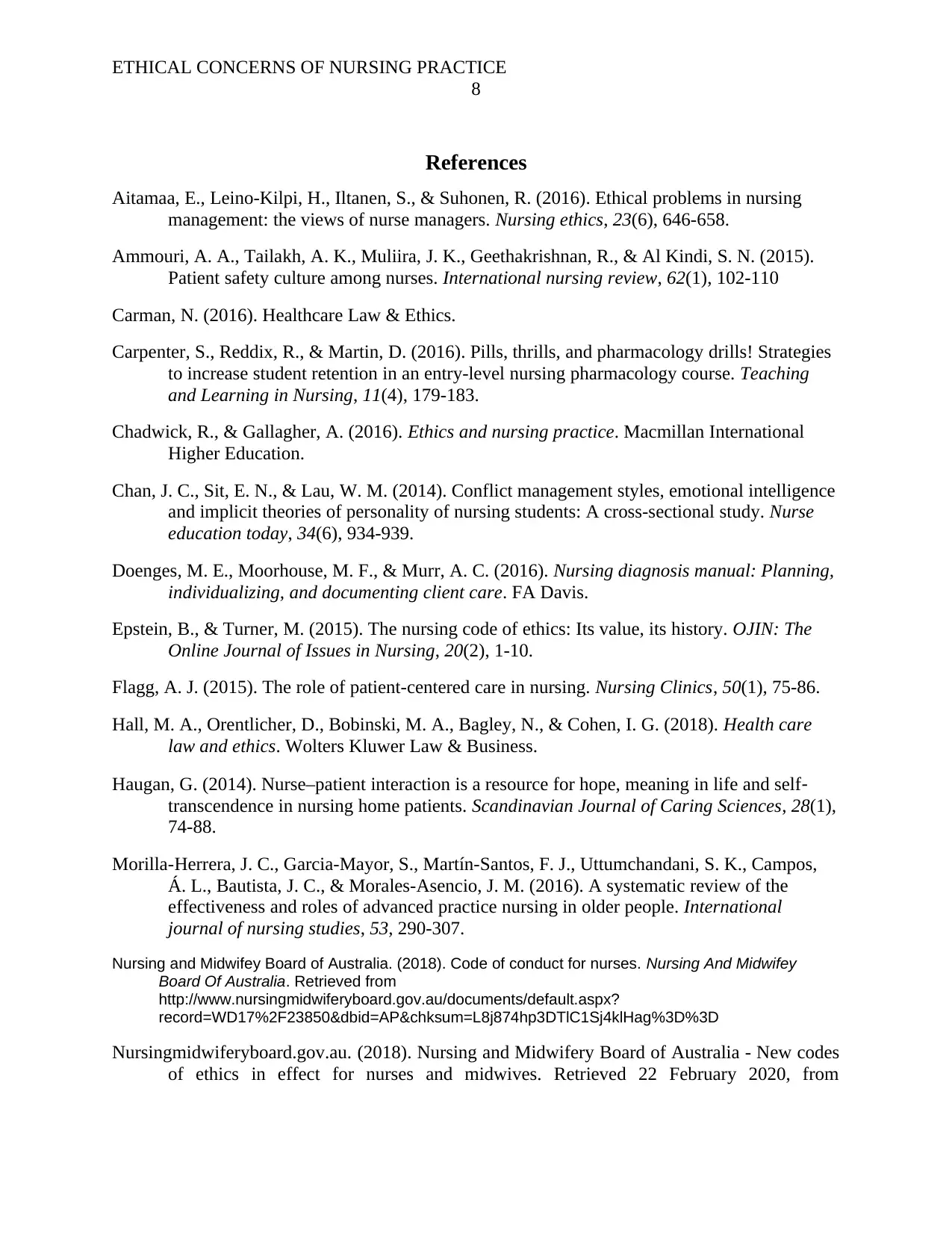
ETHICAL CONCERNS OF NURSING PRACTICE
8
References
Aitamaa, E., Leino-Kilpi, H., Iltanen, S., & Suhonen, R. (2016). Ethical problems in nursing
management: the views of nurse managers. Nursing ethics, 23(6), 646-658.
Ammouri, A. A., Tailakh, A. K., Muliira, J. K., Geethakrishnan, R., & Al Kindi, S. N. (2015).
Patient safety culture among nurses. International nursing review, 62(1), 102-110
Carman, N. (2016). Healthcare Law & Ethics.
Carpenter, S., Reddix, R., & Martin, D. (2016). Pills, thrills, and pharmacology drills! Strategies
to increase student retention in an entry-level nursing pharmacology course. Teaching
and Learning in Nursing, 11(4), 179-183.
Chadwick, R., & Gallagher, A. (2016). Ethics and nursing practice. Macmillan International
Higher Education.
Chan, J. C., Sit, E. N., & Lau, W. M. (2014). Conflict management styles, emotional intelligence
and implicit theories of personality of nursing students: A cross-sectional study. Nurse
education today, 34(6), 934-939.
Doenges, M. E., Moorhouse, M. F., & Murr, A. C. (2016). Nursing diagnosis manual: Planning,
individualizing, and documenting client care. FA Davis.
Epstein, B., & Turner, M. (2015). The nursing code of ethics: Its value, its history. OJIN: The
Online Journal of Issues in Nursing, 20(2), 1-10.
Flagg, A. J. (2015). The role of patient-centered care in nursing. Nursing Clinics, 50(1), 75-86.
Hall, M. A., Orentlicher, D., Bobinski, M. A., Bagley, N., & Cohen, I. G. (2018). Health care
law and ethics. Wolters Kluwer Law & Business.
Haugan, G. (2014). Nurse–patient interaction is a resource for hope, meaning in life and self‐
transcendence in nursing home patients. Scandinavian Journal of Caring Sciences, 28(1),
74-88.
Morilla-Herrera, J. C., Garcia-Mayor, S., Martín-Santos, F. J., Uttumchandani, S. K., Campos,
Á. L., Bautista, J. C., & Morales-Asencio, J. M. (2016). A systematic review of the
effectiveness and roles of advanced practice nursing in older people. International
journal of nursing studies, 53, 290-307.
Nursing and Midwifey Board of Australia. (2018). Code of conduct for nurses. Nursing And Midwifey
Board Of Australia. Retrieved from
http://www.nursingmidwiferyboard.gov.au/documents/default.aspx?
record=WD17%2F23850&dbid=AP&chksum=L8j874hp3DTlC1Sj4klHag%3D%3D
Nursingmidwiferyboard.gov.au. (2018). Nursing and Midwifery Board of Australia - New codes
of ethics in effect for nurses and midwives. Retrieved 22 February 2020, from
8
References
Aitamaa, E., Leino-Kilpi, H., Iltanen, S., & Suhonen, R. (2016). Ethical problems in nursing
management: the views of nurse managers. Nursing ethics, 23(6), 646-658.
Ammouri, A. A., Tailakh, A. K., Muliira, J. K., Geethakrishnan, R., & Al Kindi, S. N. (2015).
Patient safety culture among nurses. International nursing review, 62(1), 102-110
Carman, N. (2016). Healthcare Law & Ethics.
Carpenter, S., Reddix, R., & Martin, D. (2016). Pills, thrills, and pharmacology drills! Strategies
to increase student retention in an entry-level nursing pharmacology course. Teaching
and Learning in Nursing, 11(4), 179-183.
Chadwick, R., & Gallagher, A. (2016). Ethics and nursing practice. Macmillan International
Higher Education.
Chan, J. C., Sit, E. N., & Lau, W. M. (2014). Conflict management styles, emotional intelligence
and implicit theories of personality of nursing students: A cross-sectional study. Nurse
education today, 34(6), 934-939.
Doenges, M. E., Moorhouse, M. F., & Murr, A. C. (2016). Nursing diagnosis manual: Planning,
individualizing, and documenting client care. FA Davis.
Epstein, B., & Turner, M. (2015). The nursing code of ethics: Its value, its history. OJIN: The
Online Journal of Issues in Nursing, 20(2), 1-10.
Flagg, A. J. (2015). The role of patient-centered care in nursing. Nursing Clinics, 50(1), 75-86.
Hall, M. A., Orentlicher, D., Bobinski, M. A., Bagley, N., & Cohen, I. G. (2018). Health care
law and ethics. Wolters Kluwer Law & Business.
Haugan, G. (2014). Nurse–patient interaction is a resource for hope, meaning in life and self‐
transcendence in nursing home patients. Scandinavian Journal of Caring Sciences, 28(1),
74-88.
Morilla-Herrera, J. C., Garcia-Mayor, S., Martín-Santos, F. J., Uttumchandani, S. K., Campos,
Á. L., Bautista, J. C., & Morales-Asencio, J. M. (2016). A systematic review of the
effectiveness and roles of advanced practice nursing in older people. International
journal of nursing studies, 53, 290-307.
Nursing and Midwifey Board of Australia. (2018). Code of conduct for nurses. Nursing And Midwifey
Board Of Australia. Retrieved from
http://www.nursingmidwiferyboard.gov.au/documents/default.aspx?
record=WD17%2F23850&dbid=AP&chksum=L8j874hp3DTlC1Sj4klHag%3D%3D
Nursingmidwiferyboard.gov.au. (2018). Nursing and Midwifery Board of Australia - New codes
of ethics in effect for nurses and midwives. Retrieved 22 February 2020, from
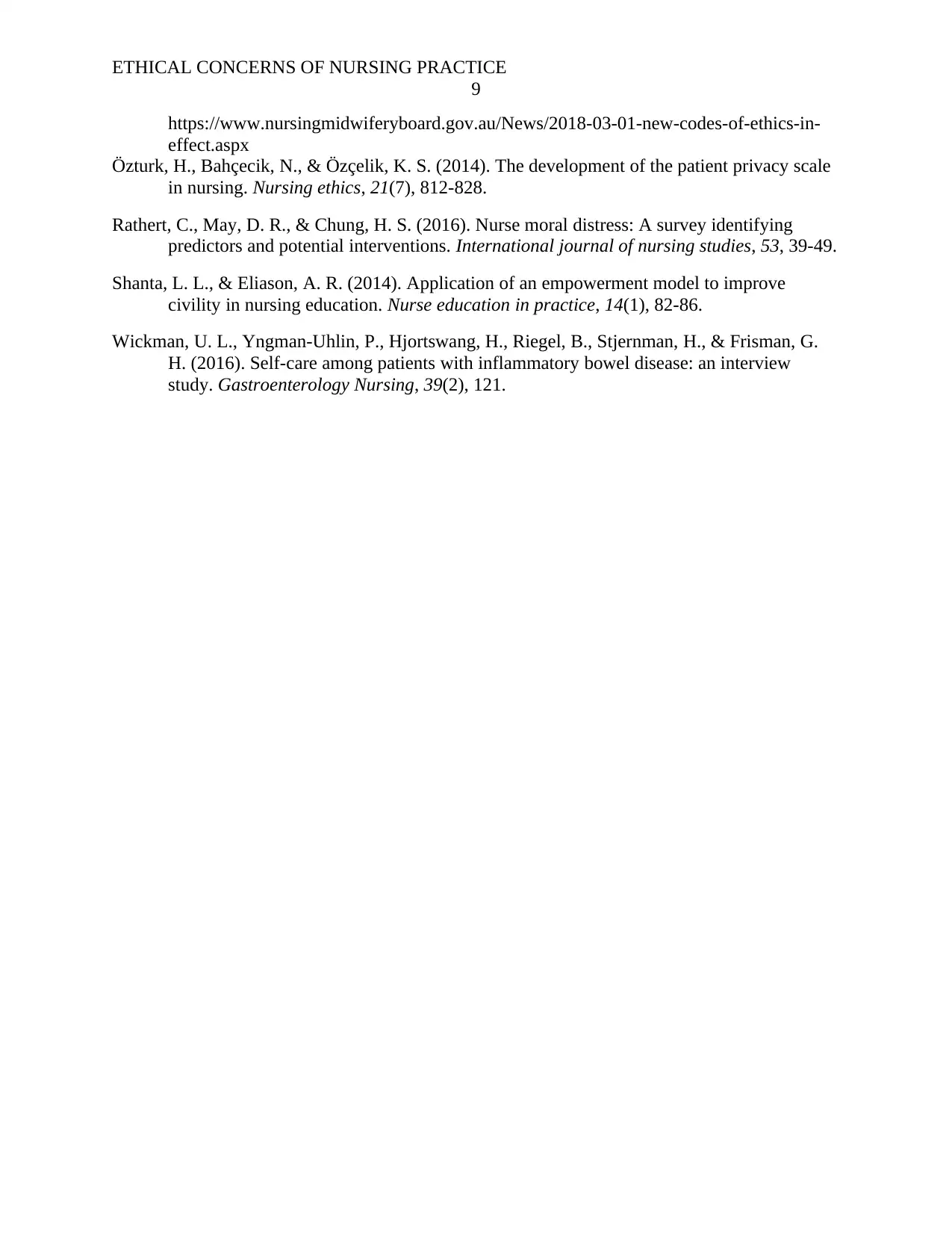
ETHICAL CONCERNS OF NURSING PRACTICE
9
https://www.nursingmidwiferyboard.gov.au/News/2018-03-01-new-codes-of-ethics-in-
effect.aspx
Özturk, H., Bahçecik, N., & Özçelik, K. S. (2014). The development of the patient privacy scale
in nursing. Nursing ethics, 21(7), 812-828.
Rathert, C., May, D. R., & Chung, H. S. (2016). Nurse moral distress: A survey identifying
predictors and potential interventions. International journal of nursing studies, 53, 39-49.
Shanta, L. L., & Eliason, A. R. (2014). Application of an empowerment model to improve
civility in nursing education. Nurse education in practice, 14(1), 82-86.
Wickman, U. L., Yngman-Uhlin, P., Hjortswang, H., Riegel, B., Stjernman, H., & Frisman, G.
H. (2016). Self-care among patients with inflammatory bowel disease: an interview
study. Gastroenterology Nursing, 39(2), 121.
9
https://www.nursingmidwiferyboard.gov.au/News/2018-03-01-new-codes-of-ethics-in-
effect.aspx
Özturk, H., Bahçecik, N., & Özçelik, K. S. (2014). The development of the patient privacy scale
in nursing. Nursing ethics, 21(7), 812-828.
Rathert, C., May, D. R., & Chung, H. S. (2016). Nurse moral distress: A survey identifying
predictors and potential interventions. International journal of nursing studies, 53, 39-49.
Shanta, L. L., & Eliason, A. R. (2014). Application of an empowerment model to improve
civility in nursing education. Nurse education in practice, 14(1), 82-86.
Wickman, U. L., Yngman-Uhlin, P., Hjortswang, H., Riegel, B., Stjernman, H., & Frisman, G.
H. (2016). Self-care among patients with inflammatory bowel disease: an interview
study. Gastroenterology Nursing, 39(2), 121.
1 out of 9
Related Documents
Your All-in-One AI-Powered Toolkit for Academic Success.
+13062052269
info@desklib.com
Available 24*7 on WhatsApp / Email
![[object Object]](/_next/static/media/star-bottom.7253800d.svg)
Unlock your academic potential
© 2024 | Zucol Services PVT LTD | All rights reserved.





